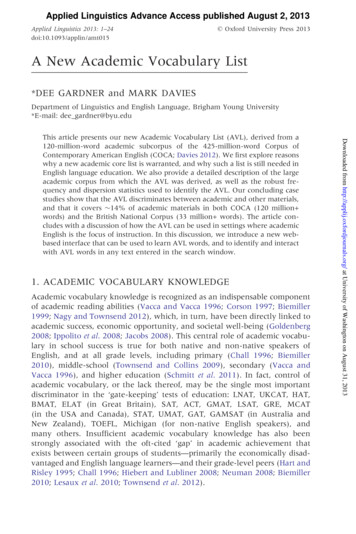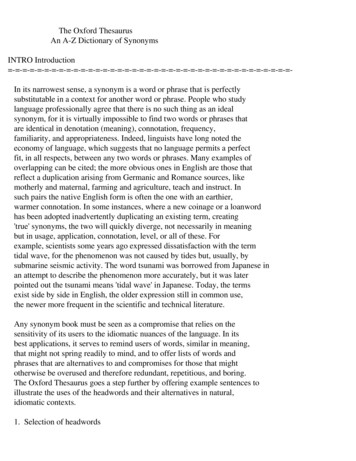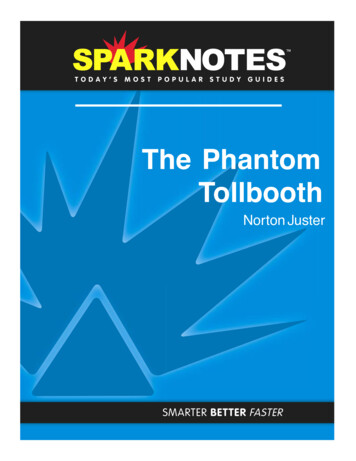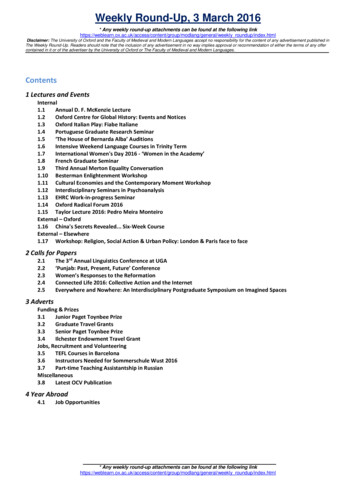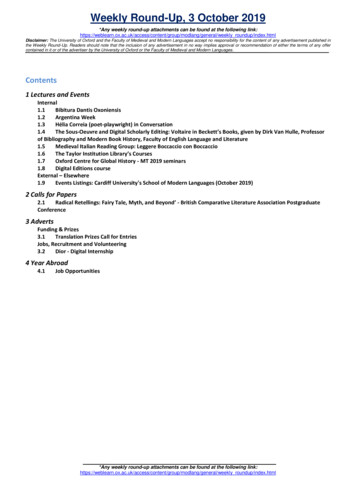
Transcription
The Oxford Handbook ofQuantitative Methods
OX F O R D L I B R A RY O F P S Y C H O L O G YEditor-in-ChiefPeter E. NathanA r e a E d i t o r s:Clinical PsychologyDavid H. BarlowCognitive NeuroscienceKevin N. Ochsner and Stephen M. KosslynCognitive PsychologyDaniel ReisbergCounseling PsychologyElizabeth M. Altmaier and Jo-Ida C. HansenDevelopmental PsychologyPhilip David ZelazoHealth PsychologyHoward S. FriedmanHistory of PsychologyDavid B. BakerMethods and MeasurementTodd D. LittleNeuropsychologyKenneth M. AdamsOrganizational PsychologySteve W. J. KozlowskiPersonality and Social PsychologyKay Deaux and Mark Snyder
OX F O R D L I B R A RY O F P S Y C H O L O G YEditor-in-Chiefpeter e. nathanThe Oxford Handbookof QuantitativeMethodsEdited byTodd D. LittleVo lu m e 2 : Stat i s t i c a l A n a ly s i s1
3Oxford University Press is a department of the University of Oxford.It furthers the University’s objective of excellence in research, scholarship,and education by publishing worldwide.Oxford New YorkAuckland Cape Town Dar es Salaam Hong Kong KarachiKuala Lumpur Madrid Melbourne Mexico City NairobiNew Delhi Shanghai Taipei TorontoWith offices inArgentina Austria Brazil Chile Czech Republic France GreeceGuatemala Hungary Italy Japan Poland Portugal SingaporeSouth Korea Switzerland Thailand Turkey Ukraine VietnamOxford is a registered trademark of Oxford University Press in the UK and certain othercountries.Published in the United States of America byOxford University Press198 Madison Avenue, New York, NY 10016 Oxford University Press 2013All rights reserved. No part of this publication may be reproduced, stored in aretrieval system, or transmitted, in any form or by any means, without the priorpermission in writing of Oxford University Press, or as expressly permitted by law,by license, or under terms agreed with the appropriate reproduction rights organization.Inquiries concerning reproduction outside the scope of the above should be sent to theRights Department, Oxford University Press, at the address above.You must not circulate this work in any other formand you must impose this same condition on any acquirer.Library of Congress Cataloging-in-Publication DataThe Oxford handbook of quantitative methods / edited by Todd D. Little.v. cm. – (Oxford library of psychology)ISBN 978–0–19–993487–4ISBN 978–0–19–993489–81. Psychology–Statistical methods. 2. Psychology–Mathematical models.BF39.O927 2012150.72 1—dc2320120150059 8 7 6 5 4 3 2 1Printed in the United States of Americaon acid-free paperI. Little, Todd D.
SHORT CONTENTSOxford Library of PsychologyAbout the EditorContributorsIndexixxiTable of ContentsChaptersviixvii1–758759v
This page intentionally left blank
OX F O R D L I B R A RY O F P SYC H O LO GYThe Oxford Library of Psychology, a landmark series of handbooks, is published byOxford University Press, one of the world’s oldest and most highly respected publishers, with a tradition of publishing significant books in psychology. The ambitious goalof the Oxford Library of Psychology is nothing less than to span a vibrant, wide-rangingfield and, in so doing, to fill a clear market need.Encompassing a comprehensive set of handbooks, organized hierarchically, theLibrary incorporates volumes at different levels, each designed to meet a distinctneed. At one level are a set of handbooks designed broadly to survey the majorsubfields of psychology; at another are numerous handbooks that cover importantcurrent focal research and scholarly areas of psychology in depth and detail. Plannedas a reflection of the dynamism of psychology, the Library will grow and expandas psychology itself develops, thereby highlighting significant new research that willimpact on the field. Adding to its accessibility and ease of use, the Library will bepublished in print and, later on, electronically.The Library surveys psychology’s principal subfields with a set of handbooks thatcapture the current status and future prospects of those major subdisciplines. This initial set includes handbooks of social and personality psychology, clinical psychology,counseling psychology, school psychology, educational psychology, industrial andorganizational psychology, cognitive psychology, cognitive neuroscience, methodsand measurements, history, neuropsychology, personality assessment, developmental psychology, and more. Each handbook undertakes to review one of psychology’smajor subdisciplines with breadth, comprehensiveness, and exemplary scholarship.In addition to these broadly conceived volumes, the Library also includes a largenumber of handbooks designed to explore in depth more specialized areas of scholarship and research, such as stress, health and coping, anxiety and related disorders,cognitive development, or child and adolescent assessment. In contrast to the broadcoverage of the subfield handbooks, each of these latter volumes focuses on an especially productive, more highly focused line of scholarship and research. Whetherat the broadest or most specific level, however, all of the Library handbooks offersynthetic coverage that reviews and evaluates the relevant past and present researchand anticipates research in the future. Each handbook in the Library includes introductory and concluding chapters written by its editor to provide a roadmap to thehandbook’s table of contents and to offer informed anticipations of significant futuredevelopments in that field.An undertaking of this scope calls for handbook editors and chapter authorswho are established scholars in the areas about which they write. Many of thevii
nation’s and world’s most productive and best-respected psychologists have agreedto edit Library handbooks or write authoritative chapters in their areas of expertise.For whom has the Oxford Library of Psychology been written? Because of its breadth,depth, and accessibility, the Library serves a diverse audience, including graduatestudents in psychology and their faculty mentors, scholars, researchers, and practitioners in psychology and related fields. Each will find in the Library the informationthey seek on the subfield or focal area of psychology in which they work or areinterested.Befitting its commitment to accessibility, each handbook includes a comprehensive index, as well as extensive references to help guide research. And because theLibrary was designed from its inception as an online as well as a print resource,its structure and contents will be readily and rationally searchable online. Further,once the Library is released online, the handbooks will be regularly and thoroughlyupdated.In summary, the Oxford Library of Psychology will grow organically to providea thoroughly informed perspective on the field of psychology—one that reflectsboth psychology’s dynamism and its increasing interdisciplinarity. Once publishedelectronically, the Library is also destined to become a uniquely valuable interactivetool, with extended search and browsing capabilities. As you begin to consult thishandbook, we sincerely hope you will share our enthusiasm for the more than 500year tradition of Oxford University Press for excellence, innovation, and quality, asexemplified by the Oxford Library of Psychology.Peter E. NathanEditor-in-ChiefOxford Library of Psychologyviiioxford library of psychology
ABOUT THE EDITORTodd D. LittleTodd D. Little, Ph.D., is a Professor of Psychology, Director of the Quantitativetraining program, Director of the undergraduate Social and Behavioral SciencesMethodology minor, and a member of the Developmental training program. Since2010, Todd has been Director of the Center for Research Methods and Data Analysis(CRMDA) at Kansas University. Little is internationally recognized for his quantitative work on various aspects of applied SEM (e.g., indicator selection, parceling,modeling developmental processes) as well as his substantive developmental research(e.g., action-control processes and motivation, coping, and self-regulation). In2001, Little was elected to membership in the Society for Multivariate ExperimentalPsychology. In 2009, he was elected President of APA’s Division 5 (Evaluation, Measurement, and Statistics) and in 2010 was elected Fellow of the division. In 2012,he was elected Fellow in the Association for Psychological Science. He founded,organizes, and teaches in the internationally renowned KU “Stats Camps” each June(see crmda.KU.edu for details of the summer training programs). Little has editedfive books related to methodology including The Oxford Handbook of QuantitativeMethods and the Guilford Handbook of Developmental Research Methods (with BrettLaursen and Noel Card). Little has been principal investigator or co-principal investigator on more than 15 grants and contracts, statistical consultant on more than 60grants and he has guided the development of more than 10 different measurementtools.ix
This page intentionally left blank
CONTRIBUTORSLeona S. AikenDepartment of PsychologyArizona State UniversityTempe, AZRawni A. AndersonCenter for Research Methodsand Data AnalysisUniversity of KansasLawrence, KSLuc AnselinGeoDa Center for Geospatial Analysisand ComputationSchool of Geographical Sciences andUrban PlanningArizona State UniversityTempe, AZAmanda N. BaraldiDepartment of PsychologyArizona State UniversityTempe, AZDavid E. BardDepartment of PediatricsUniversity of Oklahoma Health SciencesCenterOklahoma City, OKTheodore P. BeauchaineDepartment of PsychologyWashington State UniversityPullman, WAGabriëlla A.M. BloklandGenetic Epidemiology LaboratoryQueensland Institute ofMedical ResearchSchool of Psychology and Centrefor Advanced ImagingUniversity of QueenslandBrisbane, AustraliaAnnette BroseMax Plank Institute for HumanDevelopmentBerlin, GermanyMax Plank Institute for Human Cognitiveand Brain SciencesTimothy A. BrownDepartment of PsychologyBoston UniversityBoston, MATrent D. BuskirkDepartment of Community HealthBiostatistics DivisionSaint Louis UniversitySaint Louis, MONoel A. CardFamily Studies and Human DevelopmentUniversity of ArizonaTucson, AZDeborah M. CasperFamily Studies and Human DevelopmentUniversity of ArizonaTucson, AZDaniel R. CavagnaroDepartment of PsychologyThe Ohio State UniversityColumbus, OHRand D. CongerDepartment of Human and CommunityDevelopmentUniversity of California at DavisDavis, CADavid CookAbt Associates Inc.Thomas D. CookInstitute for Policy ResearchNorthwestern UniversityEvanston, ILStefany CoxeDepartment of PsychologyArizona State UniversityTempe, AZR.J. de AyalaDepartment of EducationalPsychologyUniversity of Nebraska LincolnLincoln, NExi
Pascal R. DeboeckDepartment of PsychologyUniversity of KansasLawrence, KSSarah DepaoliDepartment of Educational PsychologyUniversity of Wisconsin MadisonMadison, WICody S. DingCollege of EducationUniversity of Missouri-Saint LouisSaint Louis, MOM. Brent DonnellanDepartment of PsychologyMichigan State UniversityEast Lansing, MIDawnté R. EarlyDepartment of Human and CommunityDevelopmentUniversity of California at DavisDavis, CACraig K. EndersDepartment of PsychologyArizona State UniversityTempe, AZDavid M. Erceg-HurnSchool of PsychologyUniversity of Western AustraliaCrawley, WA, AustraliaAurelio José FigueredoDepartment of PsychologySchool of Mind, Brain, & BehaviorDivision of Family Studies and HumanDevelopmentCollege of Agriculture and Life SciencesUniversity of ArizonaTucson, AZRafael Antonio GarciaDepartment of PsychologySchool of Mind, Brain, & BehaviorUniversity of ArizonaTucson, AZAmanda C. GottschallDepartment of PsychologyArizona State UniversityTempe, AZMichael J. GreenacreDepartment of Economics and BusinessUniversitat Pompeu Fabra, BarcelonaBarcelona, SpainxiicontributorsBrian D. HaigDepartment of PsychologyUniversity of CanterburyCanterbury, New ZealandKelly HallbergInstitute for Policy ResearchNorthwestern UniversityEvanston, ILLisa L. HarlowDepartment of PsychologyUniversity of Rhode IslandKingston, RIEmily J. HartDepartment of PsychologyUniversity at BuffaloThe State University of New YorkBuffalo, NYKit-Tai HauThe Chinese University of Hong KongHong KongJoop J. HoxDepartment of Methodology and StatisticsUtrecht UniversityUtrecht, The NetherlandsJames JaccardDepartment of PsychologyFlorida International UniversityBoca Raton, FLPaul E. JohnsonDepartment of Political ScienceKansas UniversityLawrence, KSKelly M. KadlecDepartment of PsychologyUniversity of Southern CaliforniaLos Angeles, CADavid KaplanDepartment of EducationalPsychologyUniversity of Wisconsin-MadisonMadison, WIKen KelleyDepartment of ManagementUniversity of Notre DameNotre Dame, INHarvey J. KeselmanDepartment of PsychologyUniversity of ManitobaWinnipeg, Canada
Neal M. KingstonSchool of EducationUniversity of KansasLawrence, KSYasemin Kisbu-SakaryaDepartment of PsychologyArizona State UniversityTempe, AZLaura B. KramerSchool of EducationUniversity of KansasLawrence, KSTodd D. LittleCenter for Research Methods and DataAnalysisDepartment of PsychologyUniversity of KansasLawrence, KSRichard E. LucasDepartment of PsychologyMichigan State UniversityEast Lansing, MIDavid P. MacKinnonDepartment of PsychologyArizona State UniversityTempe, AZPatrick MairInstitute for Statistics and MathematicsVienna University of Economicsand BusinessVienna, AustriaHerbert W. MarshDepartment of EducationUniversity of OxfordOxford, UKKatherine E. MasynGraduate School of EducationHarvard UniversityCambridge, MAJohn J. McArdleDepartment of PsychologyUniversity of Southern CaliforniaLos Angeles, CARoderick P. McDonald†Sydney UniversitySydney, AustraliaProfessor EmeritusUniversity of Illinoisat Urbana-ChampaignProfessor EmeritusMacquarie University† April 16, 1928 – October, 29, 2011Sarah E. MedlandGenetic Epidemiology LaboratoryQueensland Institute of Medical ResearchSchool of PsychologyUniversity of QueenslandBrisbane, AustraliaPeter C. M. MolenaarDepartment of Human Developmentand Family StudiesPennsylvania State UniversityUniversity Park, PAAlexandre J.S. MorinDepartment of PsychologyUniversity of SherbrookeSherbrooke, Quebec, CanadaMiriam A. MosingGenetic Epidemiology LaboratoryQueensland Institute of Medical ResearchSchool of PsychologyUniversity of QueenslandBrisbane, AustraliaKeith E. MullerDepartment of Health Outcomesand PolicyUniversity of FloridaGainesville, FLEun-Young MunCenter of Alcohol StudiesRutgers UniversityPiscataway, NJAlan T. MurrayGeoDa Center for Geospatial Analysisand ComputationSchool of Geographical Sciencesand Urban PlanningArizona State UniversityTempe, AZJay I. MyungDepartment of PsychologyThe Ohio State UniversityColumbus, OHBenjamin NagengastDepartment of EducationOxford UniversityOxford, UKcontributorsxiii
Sally Gayle OlderbakDepartment of PsychologySchool of Mind, Brain, &BehaviorUniversity of ArizonaTucson, AZJamie M. OstrovDepartment of PsychologyUniversity at BuffaloThe State University of New YorkBuffalo, NYTrond PetersonDepartment of SociologyUniversity of California-BerkeleyBerkeley, CAMark A. PittDepartment of PsychologyThe Ohio State UniversityColumbus, OHLarry R. PriceCollege of Education and College of ScienceTexas State University-San MarcosSan Marcos, TXNilam RamDepartment of Human Development andFamily StudiesPennsylvania State UniversityUniversity Park, PAMax Plank Institute for HumanDevelopmentBerlin, GermanySergio J. ReyGeoDa Center for Geospatial Analysisand ComputationSchool of Geographical Sciences andUrban PlanningArizona State UniversityTempe, AZJoseph L. RodgersDepartment of PsychologyUniversity of OklahomaNorman, OKRobert RosenthalDepartment of PsychologyUniversity of California, RiversideRiverside, CARalph L. RosnowDepartment of PsychologyTemple UniversityPhiladelphia, PAxivcontributorsAndré A. RuppDepartment of Measurement, Statistics,and Evaluation (EDMS)University of MarylandCollege Park, MDGabriel Lee SchlomerDivision of Family Studies andHuman DevelopmentCollege of Agriculture and Life SciencesUniversity of ArizonaTucson, AZChristof SchusterDepartment of PsychologyJustus-Liebig-Unversitat GiessenGiessen, GermanyJames P. SeligDepartment of PsychologyUniversity of New MexicoAlbuquerque, NMPaul E. SpectorDepartment of PsychologyUniversity of South FloridaTampa, FLPeter M. SteinerDepartment of Educational PsychologyUniversity of Wisconsin-MadisonMadison, WICarolin StroblLudwig-Maximilians-UniversitätMünchen Faculty of Mathematics,Informatics and Statistics Instituteof StatisticsMunich, GermanyBruce ThompsonBaylor College of MedicineAustin, TXTerry T. TomazicDepartment of Sociology andCriminal JusticeSaint Louis UniversitySaint Louis, MOJames T. TownsendDepartment of Psychological andBrain SciencesIndiana UniversityBloomington, INTrisha Van ZandtDepartment of PsychologyThe Ohio State UniversityColumbus, OH
Alexander von EyeDepartments of PsychologyMichigan State UniversityEast Lansing, MIUniversity of ViennaVienna, AustriaStefan von WeberDepartment of Mechanical EngineeringHochschule Furtwangen UniversityFurtwangen im Schwarzwald, GermanyKarin J.H. VerweijGenetic Epidemiology LaboratoryQueensland Institute of Medical ResearchSchool of PsychologyUniversity of QueenslandBrisbane, AustraliaTheodore A. WallsDepartment of Behavioral ScienceUniversity of Rhode IslandKingston, RILihshing Leigh WangEducational Studies ProgramUniversity of CincinnatiCincinnati, OHAmber S. WattsCenter for Research Methods and DataAnalysis andLifespan Institute, Gerontology CenterUniversity of KansasLawrence, KSWilliam W.S. WeiDepartment of StatisticsTemple UniversityPhiladelphia, PAZhonglin WenSouth China Normal UniversityStephen G. WestDepartment of PsychologyArizona State UniversityTempe, AZKeith F. WidamanDepartment of PsychologyUniversity of California at DavisDavis, CARand R. WilcoxDepartment of PsychologyUniversity of Southern CaliforniaLos Angeles, CALisa M. WilloughbyDepartment of PsychologySaint Louis UniversitySaint Louis, MOCoady WingInstitute for Policy ResearchNorthwestern UniversityEvanston, ILPedro Sofio Abril WolfDepartment of PsychologyUniversity of Cape TownCape Town, South AfricaVivian WongSchool of Education and Social PolicyNorthwestern UniversityEvanston, ILCarol M. WoodsCenter for Research Methods andData Analysis andDepartment of PsychologyUniversity of KansasLawrence, KSWei WuCenter for Research Methods andData Analysis andDepartment of PsychologyUniversity of KansasLawrence, KSKe-Hai YuanDepartment of PsychologyUniversity of Notre DameNotre Dame, INcontributorsxv
This page intentionally left blank
CONTENTS1. Introduction 1Todd D. Little2. Overview of Traditional/Classical Statistical Approaches 7Bruce Thompson3. Generalized Linear Models 26Stefany Coxe, Stephen G. West, and Leona S. Aiken4. Categorical Methods 52Carol M. Woods5. Configural Frequency Analysis 74Alexander von Eye, Eun-Young Mun, Patrick Mair, and Stefan von Weber6. Nonparametric Statistical Techniques 106Trent D. Buskirk, Lisa M. Willoughby, and Terry J. Tomazic7. Correspondence Analysis 142Michael J. Greenacre8. Spatial Analysis 154Luc Anselin, Alan T. Murray, and Sergio J. Rey9. Analysis of Imaging Data 175Larry R. Price10. Twin Studies and Behavior Genetics 198Gabriëlla A. M. Blokland, Miriam A. Mosing, Karin J. H. Verweij, andSarah E. Medland11. Quantitative Analysis of Genes 219Sarah E. Medland12. Multidimensional Scaling 235Cody S. Ding13. Latent Variable Measurement Models 257Timothy A. Brown14. Multilevel Regression and Multilevel Structural EquationModeling 281Joop J. Hox15. Structural Equation Models 295John J. McArdle and Kelly M. Kadlecxvii
16. Developments in Mediation Analysis 338David P. MacKinnon, Yasemin Kisbu-Sakarya, and Amanda C.Gottschall17. Moderation 361Herbert W. Marsh, Kit-Tai Hau, Zhonglin Wen, Benjamin Nagengast,and Alexandre J.S. Morin18. Longitudinal Data Analysis 387Wei Wu, James P. Selig, and Todd D. Little19. Dynamical Systems and Models of Continuous Time 411Pascal R. Deboeck20. Intensive Longitudinal Data 432Theodore A. Walls21. Dynamic Factor Analysis: Modeling Person-Specific Process 441Nilam Ram, Annette Brose, and Peter C. M. Molenaar22. Time Series Analysis 458William W.S. Wei23. Analyzing Event History Data 486Trond Petersen24. Clustering and Classification 517André A. Rupp25. Latent Class Analysis and Finite Mixture Modeling 551Katherine E. Masyn26. Taxometrics 612Theodore P. Beauchaine27. Missing Data Methods 635Amanda N. Baraldi and Craig K. Enders28. Secondary Data Analysis 665M. Brent Donnellan and Richard E. Lucas29. Data Mining 678Carolin Strobl30. Meta-Analysis and Quantitative Research Synthesis 701Noel A. Card and Deborah M. Casper31. Common Fallacies in Quantitative Research Methodology 718Lihshing Leigh Wang, Amber S.Watts, Rawni A. Anderson,and Todd D. LittleIndexxviiicontents759
CHAPTER1IntroductionTodd D. LittleAbstractIn this introductory chapter to The Oxford Handbook of Quantitative Methods, I provide an overview ofthe two volumes. More specifically, I describe the rationale and motivation for the selected topics thatare presented in the volumes. I also list out my instructions to the chapter authors and then describehow the chapters fit together into thematic groupings. I also extend my sincerest gratitude to thepersons who assisted me along the way, as no work this comprehensive can be done without theconsiderable help and assistance of many persons. I conclude with how pleased I am with the qualityand comprehensiveness of the chapters that are included.Key Words: Overview; Quantitative Methods; Methodology; StatisticsOxford IntroductionHandbooks provide a crucial venue to communicate the current state of the field. They also providea one-stop source for learning and reviewing current best practices in a field. The Oxford Handbook ofQuantitative Methods serves both of these functions.The field of quantitative methods is quite broad, asyou can probably imagine. I have tried to be thorough in my selection of topics to be covered. As withany handbook of this magnitude, some topics wereall set to have a contribution submitted, only to havesome unforeseen hindrance preclude its inclusionat the last minute (e.g., graphical representationsof data, ecological inference, history of quantitative methods). Some topics overlap with others andmay not have found their way to become a separatechapter, but their fundamental elements are foundin parts of other chapters.This handbook is one of many that OxfordUniversity Press (OUP) is assembling but will bethe capstone methodology handbook. As many ofyou know, OUP is building a comprehensive andsynthetic Library of Handbooks covering the fieldof psychology (the Editor-in-Chief of the libraryis Peter Nathan, University of Iowa FoundationDistinguished Professor of Psychology and PublicHealth). The library comprises handbooks in thetruest sense of the word: books that summarize andsynthesize a topic, define the current scholarship,and set the agenda for future research. Each handbook is published as a bound book, and it will alsobe developed for electronic delivery. In this format,the content will be integrated across topics and available as a fully integrated electronic library. I thinkthe idea of a comprehensive electronic library is veryforward-thinking. This format is a very attractiveopportunity to have a fully comprehensive and upto-date handbook of methods in our field. Hence,I agreed to take on the role of editor of The OxfordHandbook of Quantitative Methods.I am very pleased with the quality of the workthat each author provided. As per my request to thecontributing authors, each chapter is meant to beboth accessible and comprehensive; nearly all the1
authors were very responsive to my requests. Theguidelines I asked authors to consider were: Handbook chapters should be comprehensiveand authoritative; readers will rely heavily on thesechapters, particularly when they move to the onlineformat. Handbook chapters should present not onlythe strengths of the topic covered but also anylimitations. Handbook chapters should make all assumptions underlying the topic explicit. Regarding citations, handbook chaptersshould cover the historical origins as well as therecent renditions of a given key topic. Handbook chapters should not present onesided views on any debate; rather, they should reportthe issues and present the arguments—both pro andcon. Authors can direct readers to other platformswhere a position piece is presented. To facilitate the online linkages, handbookchapters should point to other online resourcesrelated to the topic presented. Every element of every formula presented mustbe explicitly explained; assume no knowledge of howto read formulae. Examples, examples, examples, and, whenin doubt, provide an example! Concrete examplesare absolutely critical to communicate quantitativecontent. Avoid jargon and acronyms. Please spell outacronyms, and if you use jargon, please remind thereader of the meaning or definition of the jargonevery three to four times it is used; similarly, if youuse an acronym, then remind the reader of what itmeans every three to four times it is used. Use active voice, and do not shy away from theuse of I/me or we/us. Channel how you lecture onthe topic. It will create a crisp and enjoyable read. Do not start a sentence with “This” followedby a verb. The referent to “this” must be restatedbecause of the ambiguity this creates. This generalguideline should be followed as a rule!Authors, like editors, have preferences and habits,so you will find places, chapters, and so on wheresome of my admonitions were not followed. But thequality of the product that each chapter provides isnonetheless uncompromised. We have established aWiki-based resource page for the handbook, whichcan be found at crmda.KU.edu/oxford. Each authorhas been asked to maintain and upload materials to2introductionsupport his or her chapter contribution. At the top ofthat page is a link that encourages you to offer comments and suggestions on the topics and coverageof the handbook. These comments will be reviewedand integrated into future editions of this handbook.I encourage you, therefore, to take advantage of thisopportunity to help shape the directions and contentcoverage of this handbook.Statistical software has blossomed with the adventof hardware that provides the necessary speed andmemory and programming languages coupled withnumerical algorithms that are more efficient andoptimized than yesteryear. These software advanceshave allowed many of the advances in modern statistics to become accessible to the typical end-user.Modern missing data algorithms and Bayesian estimation procedures, for example, have been thebeneficiaries of these advances. Of course, some ofthe software developments have included simplifiedinterfaces with slick graphic user interfaces. The critical options are usually prefilled with default settings.These latter two aspects of advancing software areunfortunate because they lead to mindless applications of the statistical techniques. I would preferthat options not be set as default but, rather, havethe software prompt the user to make a choice (andgive good help for what each choice means). I wouldprefer that a complete script of the GUI choices andthe order in which steps were taken be automaticallysaved and displayed.I have organized the handbook by starting withsome basics. It begins with the philosophical underpinnings associated with science and quantitativemethods (Haig, Chapter 2, Volume 1) followedby a discussion of how to construct theories andmodels so that they can be tested empiricallyand the best model selected (Jaccard, Chapter 5,Volume 1). I then turn to an enlightened discussion of ethics in the conduct of quantitative research(Rosnow & Rosenbloom, Chapter 3, Volume 1)and related issues when quantitative methods areapplied in special populations (Widaman, Early, &Conger, Chapter 4, Volume 1). Harlow (Chapter 6,Volume 1) follows with an encompassing and impassioned discussion of teaching quantitative methods.The theme in the next grouping of chapterscenters on measurement issues. First, the lateMcDonald (Chapter 7, Volume 1) provides a thorough overview of Modern Test Theory.1 Ayala(Chapter 8, Volume 1) adds a detailed discussion ofItem Response Theory as an essential measurementand analysis tool. After these principles of measurement are discussed, the principles and practices
surrounding survey design and measure development are presented (Spector, Chapter 9, Volume 1).Kingston and Kramer (Chapter 10, Volume 1) further this discussion in the context of high-stakestesting.A next grouping of chapters covers various designissues. Kelley (Chapter 11, Volume 1) beginsthis section by covering issues of power, effectsize, and sample size planning. Hallberg, Wing,Wong, and Cook (Chapter 12, Volume 1) thenaddress key experimental designs for causal inference: the gold standard randomized clinical trials(RCT) design and the underutilized regression discontinuity design. Some key quasi-experimentalprocedures for comparing groups are discussed inSteiner and Cooks’ (Chapter 13, Volume 1) chapteron using matching and propensity scores. Finally,Van Zandt and Townsend (Chapter 14, Volume 1)provide a detailed discussion of the designs for andanalyses of response time experiments. I put observational methods (Ostrov & Hart, Chapter 15, Volume 1), epidemiological methods (Bard, Rodgers,& Mueller, Chapter 16, Volume 1), and program evaluation (Figueredo, Olderbak, Schlomer,Garcia, & Wolf, Chapter 17, Volume 1) in withthese chapters because they address more collectionand design issues, although the discussion of program evaluation also addresses the unique analysisand presentation issues.I have a stellar group of chapters related to estimation issues. Yuan and Schuster (Chapter 18,Volume 1) provide an overview of statistical estimation method; Erceg-Hurn, Wilcox, and Keselman(Chapter 19, Volume 1) provide a nice complement with a focus on robust estimation techniques. Bayesian statistical e
Library was designed from its inception as an online as well as a print resource, its structure and contents will be readily and rationally searchable online. Further, once the Library is released online, the handbooks will be regularly and thoroughly updated. In summary, the Oxfo


